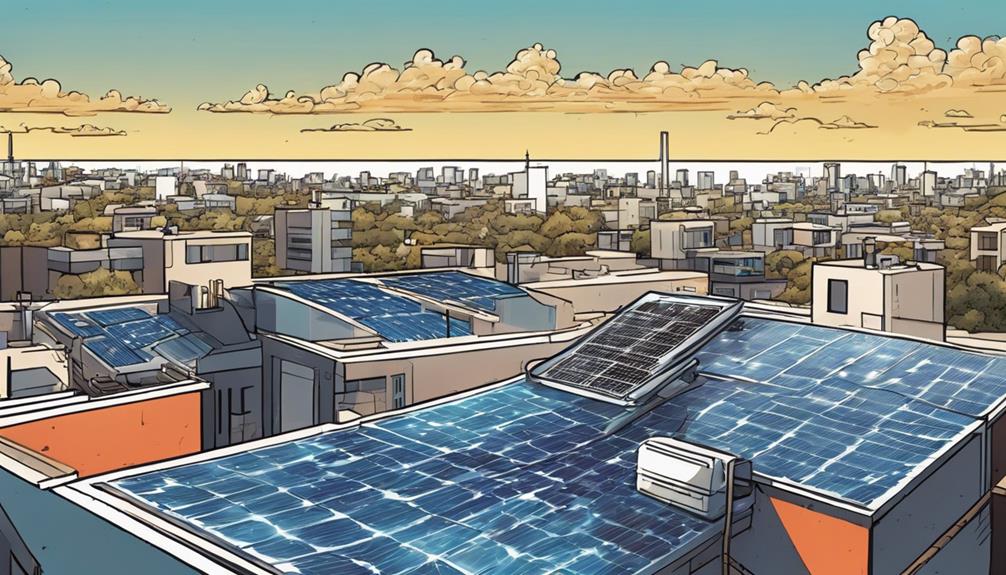Polar regions get less solar energy than equatorial regions because of the Earth's tilt and its orbit around the Sun. The angle of sunlight affects how much solar radiation reaches the poles. This is why the polar areas receive sunlight at a slanted angle, making the energy spread out and less intense. The shorter days in polar regions also play a role in limiting the amount of sunlight they absorb. If you want to understand more about this solar energy distribution, keep exploring the factors influencing it.
Key Takeaways
- Oblique sunlight angles in polar regions reduce solar energy absorption efficiency.
- Earth's curvature causes sunlight to spread out, decreasing energy concentration in polar areas.
- Day length discrepancy limits solar absorption in polar regions due to shorter days.
- Equatorial regions receive more direct sunlight due to the Earth's curvature.
- Earth's elliptical orbit leads to distance variations, affecting solar energy distribution.
Solar Constant and Insolation Variances
The solar constant, averaging 1368W/m2 at the thermopause, experiences slight fluctuations impacted by solar disturbances such as sun spots.
Sun spots, part of an 11-year cycle, can influence the solar constant by up to 1 W/m2, affecting the amount of insolation reaching Earth's surface.
Earth's distance from the Sun varies due to its elliptical orbit, with aphelion in July (farthest) and perihelion in January (closest), impacting the solar energy received.
The transparency of the atmosphere, influenced by gases and water vapor, also plays a role in determining the insolation levels experienced on Earth.
This variance in insolation is particularly noticeable between polar regions and equatorial regions, with factors like the angle of incidence of the sun's rays and the duration of daylight contributing to the differences in solar energy received in these distinct regions.
Impact of Sun's Angle on Solar Energy

As sunlight strikes the Earth at varying angles due to its spherical shape, the impact on solar energy absorption differs noticeably between Polar Regions and Equatorial Regions. The angle at which the sun's rays hit the Earth's surface plays a pivotal role in determining the amount of solar energy received.
In Polar Regions, the sun's angle is much steeper, causing the solar radiation to spread out over a larger area and reducing the energy absorbed. This is in contrast to Equatorial Regions, where the sun's rays hit the surface more directly, leading to higher solar energy absorption.
The Earth's curvature results in varying angles of sunlight at different latitudes. At higher latitudes, such as the poles, the sun's rays hit the surface at a less direct angle, leading to lower solar energy absorption. Conversely, during the equinox, when the sun is directly overhead at the equator, maximum solar energy is absorbed due to the more direct angle of sunlight.
Consequently, the angle of the sun significantly influences the amount of solar radiation received in Polar Regions compared to Equatorial Regions.
Day Length Discrepancy and Solar Absorption

In regions near the poles, where day length varies considerably, solar absorption is prominently affected by the duration of daylight.
Polar Regions experience significant daylight discrepancy compared to Equatorial Regions, leading to lower solar energy intake. The angle of sunlight hitting the Polar Regions is more oblique, causing a spread-out distribution of solar radiation that reduces the efficiency of energy absorption.
With shorter days and longer nights in the polar areas, there's limited time for sunlight to reach the surface and be absorbed, unlike the consistent 12 hours of daylight experienced at the equator, which maximizes energy absorption.
This day length difference between the poles and the equator plays a pivotal role in determining the overall solar energy intake in these regions, highlighting how variations in daylight duration can impact the efficiency of solar energy absorption.
Earth's Distance From Sun Influence

Earth's distance from the Sun significantly influences the amount of solar energy received in different regions. The Earth follows an elliptical orbit around the Sun, leading to distance variations throughout the year. At its farthest point from the Sun (aphelion), which occurs around July, the energy received in the Northern Hemisphere decreases by about 7%. Conversely, during perihelion in January, when the Earth is closest to the Sun, there is a higher intensity of solar radiation globally. These distance variations impact the solar energy levels observed between polar and equatorial regions. Equatorial regions receive more direct sunlight due to their proximity to the Sun, resulting in higher solar energy levels compared to polar regions. The table below summarizes the influence of Earth's distance from the Sun on solar energy distribution:
| Earth-Sun Distance | Solar Energy Levels | Region |
|---|---|---|
| Aphelion (Farthest) | Decreased by 7% | Northern Hemisphere |
| Perihelion (Closest) | Increased intensity | Global |
| Polar vs. Equatorial | Varied due to proximity | Comparison |
Transparency of the Atmosphere in Solar Energy

The transparency of the atmosphere greatly impacts how solar energy is distributed and absorbed on Earth. Atmospheric gases like ozone and water vapor play an essential role in selectively absorbing and scattering solar radiation, influencing the amount of energy that reaches the Earth's surface.
Water vapor, specifically, contributes to the greenhouse effect by absorbing infrared radiation, affecting solar energy distribution. The composition of the atmosphere, including gases like nitrogen, oxygen, and carbon dioxide, also influences the transparency of solar energy and the levels of insolation.
As sunlight interacts with atmospheric gases, the spectrum of incoming radiation is altered, leading to changes in the solar energy spectrum available for absorption at different latitudes. This process of absorption and scattering by atmospheric gases ultimately determines the amount of solar energy that can be absorbed on Earth's surface, impacting the distribution of solar energy across various regions.
Frequently Asked Questions
Why More Solar Energy Reaches the Equatorial Region Than the Polar Regions?
You receive more solar energy at the equator than the poles because the sun's rays hit the equator more directly, concentrating heat. This direct angle maximizes energy absorption, while sunlight hitting the poles spreads out, reducing intensity.
Why Do the Polar Regions Receive Less Sunlight Than the Equator?
You experience reduced sunlight in polar regions compared to the equator due to the low angle of solar rays. The Earth's shape spreads out sunlight at higher latitudes, resulting in lower solar intensity at the poles.
Why Is There Less Solar Intensity in Polar Regions?
In Polar Regions, solar intensity is lower due to the Earth's curvature causing sunlight to strike at a shallow angle. The spherical shape of the Earth spreads out sunlight, making it less concentrated at higher latitudes.
What Causes the Poles to Receive Less Solar Energy Than the Equator Does?
The reason the poles receive less solar energy than the equator is due to the oblique angle of sunlight hitting them. This results in less concentrated sunlight, spreading out the energy and reducing absorption compared to the equator.
What Causes the Discrepancy in Solar Energy Received Between Polar and Equatorial Regions?
The discrepancy in solar energy at Earth’s surface between polar and equatorial regions is primarily due to the angle at which the sun’s rays hit the Earth. In the polar regions, sunlight strikes at a lower angle, spreading the same amount of energy over a larger area, leading to less solar energy received compared to the concentrated sunlight in the equatorial regions.
Conclusion
So, now you know why polar regions receive less solar energy than equatorial regions.
On average, the amount of solar energy received at the poles is about 40% less than at the equator due to a combination of factors such as the Earth's tilt, the length of the day, and the angle of the sun.
This disparity in solar energy distribution plays a significant role in shaping the climate and ecosystems of these regions.










